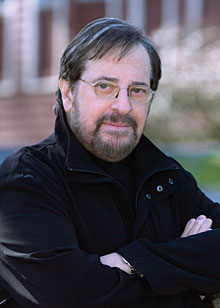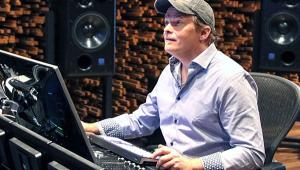HT Talks To . . . Phil Ramone
 You're a man of many talents, but I'd like to focus on your work as a record producer. please explain exactly what a producer's job entails.
You're a man of many talents, but I'd like to focus on your work as a record producer. please explain exactly what a producer's job entails.
It's analogous to what directors do with actors. The producer is there to motivate the performances, he's the "ears" of the artist, he is there to be objective, to encourage and guide the session. Artists can self-produce, and many do, but, most of the time, they need somebody in the control room to translate the music in the best possible terms.
You're also picking tunes and working on the arrangements before the session begins?
Absolutely, we're part of the whole process. You wouldn't be called a producer unless you were participating in that. When an artist shares a newborn song with you, you can give them objective and honest advice. One good suggestion can spur a lot of the production that follows.
In the studio, that's your domain.
It's a private sanctuary, and that makes it easier for the producer and the artist to become very close. It's a remarkably intimate, very private relationship—kind of like what you have, hopefully, with your family. I find it's better not to have a crowd of friends in the studio, so the artist can be completely free. It's become something of a house rule with me—no cell phones. I don't want the phone ringing in the control room; I don't want assistants picking up the phone. If we can get away from that for two or three hours, you'd be amazed how much we can get done.
Developing a long-term working relationship with an artist like Billy Joel must be especially rewarding. I suppose you really get a feel for what he needs to bring out the best in his songs?
Billy was great about trusting his time with me and the band. Opinions flowed freely, and everyone in the band said what was on their minds. But Billy and I could just look at each other or just flick a finger, and he knew, come on, let's do it again. It's an unspoken thing. Even the food breaks would have their effects. Pizza was always good.
So food is part of the creative process?
It becomes part of the humor of it. "No, no, no, we had Chinese food two nights in a row." But how did the song go? "It was great." So maybe the Chinese made it better?
 Any big clashes with your artists?
Any big clashes with your artists?
If you have a good working relationship, you can have a disagreement, but, if you throw a hissy fit, you're going to lose. I've always said, "If it's a hit, it's the artist's record, but, if it's a bad record, it's the producer's."
But I suppose dealing with tension is part of your job?
That's true—sometimes the aggravation can drive the artist to a different place. I don't like to work in an overly tense situation, but I know how to make it work when things aren't going well.
You worked with Kevin Spacey on the Bobby Darin bio film, Beyond the Sea—I could have sworn that Spacey and the band were playing live.
The trick to that was that I prerecorded most of the music, but I also had real musicians playing on the set. That way, I could use either the prerecorded or live performances, whichever was better. Kevin sang live all the time. The emotional power of the performances was always real.
What sort of tricks of the trade have you learned over the years?
One of my rules is to start recording right away and save everything. I find that, when the band first comes in and they're tuning and trying things, sometimes great ideas come out. When they get serious about making the record, they sometimes forget all of the instinctive things they were doing early on—the pulling of a string or bending a note. When Paul [Simon] was first rehearsing "Loves Me Like a Rock" with the Dixie Hummingbirds vocal group, they were stamping their feet, and he's plunking away on the guitar, getting ready for the next day's recording with the rhythm section. That didn't work, so, in the end, we went back to the rehearsal tape and added other instruments. It was magic.
So there's no predetermined road map for a Phil Ramone session?
You come with a clean slate to work with Paul Simon—it's the same with Billy Joel, Paul McCartney—a lot of writers work that way. "Maybe this should be faster. Maybe it should be a 2/4 feel—or just musically a different animal than what it is." Sometimes they need an hour or so to get warmed up, and then suddenly they're ready. The art of recording is capturing the emotion.
Some artists work a lot faster than others?
Oh, sure. Some don't feel a need to keep milking the cow until you have 50 takes. It's a question of how they feel, but some great artists do it for months and months. Paul [Simon] takes his time, and, still, he's not afraid to use early takes. I recorded Bob Dylan's Blood on the Tracks album over three or four nights. He wouldn't say, "Let's talk about this, or try this." I kept the tape rolling because it wasn't unlike him to start with one song, change to something else, and come back to the first thing. The spontaneity of the band and him was something—once he got in the zone, it was like watching a great hitter.
Right, like an athlete. when you're in the middle of a project like that, do you have any inkling that the record will take on iconic status?
When the songs work, there's joy in the control room, and everything just comes together. But that doesn't mean it's a hit. We celebrate the performance, and someone might say, "I can hear it on the radio." But that's about it.
 You're famous for keeping your cool when the going gets rough, on live TV no less!
You're famous for keeping your cool when the going gets rough, on live TV no less!
There was the time when I was working on the Grammys, and Luciano Pavarotti whispered in my ear, "I can't sing." This was 20 minutes before he was supposed to go on. As luck would have it, I had just worked with Aretha Franklin for a charity event where she sang "Nessun Dorma," so I ran up to her dressing room and asked her if she could do that aria. She didn't know the arrangement. So, I told her there's a 30-voice choir that'll sing the intro, and then it's all you. And then the orchestration will come in behind you. It's a little lower than the key you sing it in, but it is either going to work or it isn't." I went back to the audio truck and said, "Let's pray." When she finished, the audience was on its feet, and there were tears on their faces.
I take it that The Frank Sinatra Duets sessions were only slightly less challenging.
At that point, he hadn't recorded in 10 years, and we kept trying to make him understand that making this record would be so important. He finally said, "I'll do it, but I don't want to deal with my duet partner in the room. Can you figure out how to do that?" I said, "Yeah, I'll figure it out." We set him up nightclub style with a wireless handheld mike, and he sang live with a big band. It went on to be a huge success and a wonderful record for him.
Billy Joel's The Stranger was one of Sony's first Super Audio CDs. Why have SACD and DVD-Audio stalled in the marketplace?
We introduced the public to two formats at the same time, and they chose not to buy either one. Surround sound should be the message—not DVD-Audio or 5.1 surround—they don't mean anything to the average record buyer. We owe the public a lot, and, to get their business back, we have to offer real value. If it's good, they'll come. I think the DualDisc may work.
So you're doing surround mixes on most of your current projects?
Yes, and when they ask, "Can we, will we, should we?" I'm always thinking about what I can do with it. I think the back catalog also needs to be looked at.
Where will downloading lead to—what's the future role of record labels?
If you want to look at the positive side of it, you have to realize people want what they want. There are new ways to run the paradigms in the retail world. It can't be the way it was done over the past 50 years.
























































